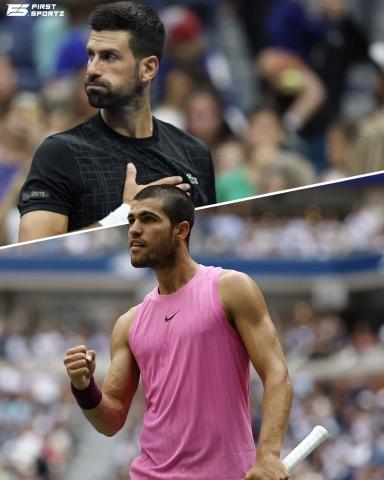
A New King Hardens His Crown, Dethroning Djokovic in US Open Semifinal NEW YORK – In a match that felt less like a semifinal and more like a coronation, Carlos Alcaraz announced the arrival of a new era on hard courts. With breathtaking power, tactical maturity, and unshakable nerve, the 20-year-old Spaniard dethroned the 23-time major champion Novak Djokovic 6-4, 7-6(4), 6-2 to secure his place in a second US Open final.
The victory is monumental on multiple fronts. It marks Alcaraz’s first hard-court win over the Serbian legend, closing their head-to-head record to a tantalizing 4-5. More importantly, it halts Djokovic’s relentless pursuit of a 24th Grand Slam title and signals a definitive shift in the landscape of men's tennis. For the third consecutive major tournament, Alcaraz will play for the title.
Match Analysis: A Tale of Two Key Battles From the first ball, the match was a stark contrast to their epic Wimbledon final. Then, it was a battle of attrition and guile on grass. On the hard courts of Arthur Ashe Stadium, it became a ferocious war of first-strike tennis and physicality, a war that Alcaraz won decisively.
1. The Serve and Return Dynamic: This was the foundation of Alcaraz’s victory. His serve, often considered the most improvable part of his game, was a weapon. He consistently found free points with well-placed serves wide in the deuce court and up the T in the ad court, neutralizing Djokovic’s reputation as the greatest returner of all time. Conversely, Alcaraz stood inches inside the baseline to receive Djokovic’s second serve, punishing it with deep, aggressive returns that immediately yanked the defending champion out of position. Djokovic never found a rhythm on his delivery, and it cost him dearly.
2. Neutralizing the Novak Backhand: Djokovic’s cross-court backhand is the metronome of his game, a shot he uses to dictate rallies and exert relentless pressure. Alcaraz had a clear game plan: avoid the backhand-to-backhand exchanges. He did this by ruthlessly attacking Djokovic’s forehand with his own punishing forehand, a shot that generates more topspin and pace. He also used the drop shot not as a trick, but as a strategic tool to drag the 36-year-old Djokovic forward, exposing him to passing shots and exhausting his legs for the battles to come.
The Djokovic Conundrum: What Went Wrong? For Novak Djokovic, this loss will sting. It wasn't a case of him playing poorly, but rather of him being outplayed and out-thought by a younger, hungrier opponent. ·
Lack of First Serve: Djokovic’s first-serve percentage was alarmingly low, especially in the first set. This allowed Alcaraz to feast on second serves, breaking twice and seizing immediate control. · Uncharacteristic Errors: Under the constant pressure of Alcaraz’s depth and power, Djokovic’s famed consistency cracked. His down-the-line backhand, usually a lethal weapon, found the net with surprising frequency. The frustration was visible, culminating in a racquet-smashing incident early in the third set that signaled the end was near. ·
The Physical Gap: The cumulative effect of two tight sets was evident. At 36, Djokovic looked a step slow in the third, unable to match the explosive movement and recovery of his 20-year-old rival. The spring in his legs, so crucial for his defensive prowess, was gone. Strategic Adjustments for the Future For Djokovic to regain supremacy in this burgeoning rivalry, adjustments are necessary. He must:
1. Reclaim the Serve: A higher first-serve percentage is non-negotiable. It’s the key to starting points on his terms and keeping Alcaraz from teeing off on returns.
2. Embrace Aggression: Playing neutral, cross-court rallies against Alcaraz is a losing strategy. Djokovic must take the ball earlier, be more willing to go down the line, and use the short, angled slice to disrupt Alcaraz’s immense power base.
3. Shorten the Points: While he can still win long rallies, the energy expenditure is disproportionate. Djokovic may need to adopt a more aggressive returning position and look to end points at the net more frequently to preserve his body over a potential five-set clash. For Carlos Alcaraz, this was more than a win; it was a statement. He didn’t just beat Novak Djokovic; he solved him on a surface where the Serbian has been virtually untouchable for over a decade. He proved his Wimbledon victory was no fluke and that his game translates perfectly to the hard courts where the majority of tennis is played. The torch has not merely been passed; it has been seized. As Carlos Alcaraz marches into his third consecutive Grand Slam final, the tennis world is witnessing the solidification of a new king, one whose reign may only be beginning.
